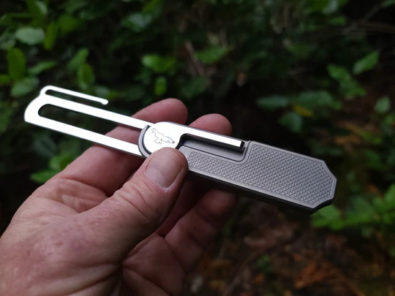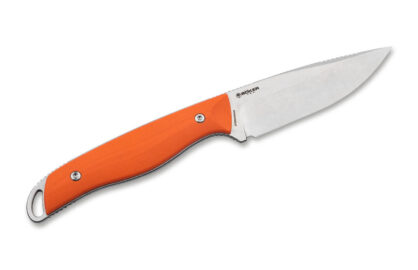Badfeather Knives Preps Sheathless EDC Fixed Blade for Release

Badfeather Knives is a brand new knife company working to get its first product, the Raider Creek, out into the world. The Raider Creek’s major selling point is its construction: essentially a fixed blade, it uses a sliding bolt mechanism to retract or extend its full tang, 3-inch blade into or out of a titanium handle; in the fully closed position, the back portion of the tang protrudes from the other side of the handle, allowing for use of the pocket hook style pocket clip, so the Raider Creek can be carried like a (large) EDC folder.
We sat down to talk to Badfeather Knives founder Dan Vorhis about the company and its first creation; you can read the interview below. If you’re interested in how to get a Raider Creek: The plan is to eventually run a Kickstarter, but Vorhis is taking his time with that, making sure everything is lined up for a successful project launch. Currently, the best way to stay abreast on the Raider Creek is through the Badfeather Knives website here.
What were your main priorities when designing the Raider Creek?
As a product designer, simplicity and durability have always been two of my cornerstones. I’ve always liked the simple toughness of a fixed-blade knife and wanted to design an EDC approaching that simplicity and toughness.
Do you envision this as a knife people carry with them every day in an urban/suburban
environment, or is it meant more for outdoorsmen?
I think of the Raider Creek as an everyday working knife. Regardless of where you live or what you do on the weekend, anyone who likes a tough, hefty EDC, has a pocket that can fit a 7-inch knife, and wants a knife designed to be used hard – that’s who this is for. This is not specifically designed as a urban/suburban or hunting/fishing knife.
What do you view as the advantages of this sliding design vs. standard fixed blades and
folders? Disadvantages?
– Disadvantages
The Raider Creek has a 3-inch blade, and it will always be longer than any folding knife with a 3-inch blade. At total length of about 7 inches, Raider Creek is probably the longest knife that will fit in a pocket – and it might not fit in some smaller pockets. So a folding knife will always have that advantage.

– Advantages
This knife has no joint. A full-tanged blade will be stiffer than any jointed blade. And the more a knife is used, the more that advantage comes into focus. Used joints get sloppier.
The locking mechanism on this knife is straightforward and robust. It is basically a big bolt and nut squeezing the blade/tang. It works like a vice, to lock the blade in or out. You can torque it down pretty hard if need be.
If I have to pound the Raider Creek into a timber for some reason, a mallet will hit the rear end of the tang, not the handle – basically a bar of steel. If I have to puncture or pry something, I would much rather have the Raider Creek in my hand than a jointed knife.
There are fewer parts to the Raider Creek. Our knife has 6 parts. Most modern pocket knives have 20, 25, 30 parts. Complex systems are more likely to fail. For example, those ceramic bearings that make a knife so quick and smooth to open? Use the knife to pry on something, and they can become a liability. Or those tiny screws that hold the pocket clip on a lot of knives, or hold a knife together? We don’t have those.
This knife can be field stripped for cleaning – handy when you are hunting, fishing, or in a gritty environment.
You can lock the blade of the Raider Creek out at any length. You can expose just the tip, for example, when you are opening a box, or skinning an animal.
Because our knife is easy to take apart and put back together, you can replace parts easily. When a blade gets worn from sharpening, we will offer replacement blades (and/or other parts, as necessary) so you don’t have to buy a whole new knife.
Like with any new thing, there will be a learning curve. First thing I did when I opened our first production prototype was poke my hand when the tip came out the handle. And I designed the damn thing. But I remember when I was a kid, learning to keep my fingers out of the way when I snapped my first “Camp King” closed.
Now that I’ve been carrying the Raider Creek for a few months, I open and close it easily with one hand – no thought required. I lock it down tightly before putting it in my pocket – and don’t have to think about that, either. I can strip the knife, sharpen it, clean it, adjust, and oil it in about two minutes. It has the heft that I like. I love the CPM-S35VN steel – how it holds an edge, how easy it is to keep sharp. And because I’ve lost a bunch of knives over the years (snatched out of my pocket by a twig or fencing), I like this knife. It rides deep in my pocket with its very low-profile pocket hook, and doesn’t seem to want to jump out.
One thing I had people ask me when I showed them the Raider Creek was their concern
that it could come loose in the pocket and the blade slide out accidentally. Have you
considered some kind of secondary safety feature (like a removable cap or similar)?
I’d bet money it was the brother of the inventor of the first folding knife who first piped up something like, “It will never work! You’ll cut your fingers when you try to close it!” Yet people have been using friction folders, with essentially no locking mechanism, since maybe 500 BCE? Yes, the Raider Creek is a new kind of knife. Yes, there will be a learning curve. You’ll want to learn about the knife after you get one – how to take it apart, how to adjust it. But it’s essentially like a parking brake – if you use it, the car doesn’t roll.

In terms of lock strength, how does the Raider Creek’s lever lock compare to the
durability of the standard folding knife lock?
I’ve seen a couple videos of a “lock strength test”, where a folding knife with the blade locked out is exposed to ever-increasing weight/tension on the handle (as if trying to force the blade to close into the handle) until the locking mechanism fails. Since the Raider Creek has no joint, that wouldn’t be a fair test – I would expect Raider Creek to do very well. You could pull or torque it any which way, and it would probably outperform a folding knife. I’m not sure what the toughest test would look like to compare the Raider Creek to a folding knife – maybe a puncture test?
At some amount of force, when RC’s locking mechanism does start to slip, the blade would slide back into the handle. It would not collapse or fold into somebody’s hand. I’d rather be holding the Raider Creek.
Is this mechanism patented/will it be patented? Do you intend to use this style of
construction for other knives in the future (bigger, smaller, different blades, etc.)?
We have done “due diligence” on the IPP for the various innovations that can be seen with this knife (and some other knife designs in the wings). I see a family of knives based upon the “fixed-blade, handle as sheath” concept. I’ve rough-prototyped maybe 30 different knife designs along this vein.
What do you envision as the future for Badfeather Knives? Custom stuff, production,
collaborations, etc.?
The “fixed blade knife, with handle as sheath” concept lends itself to a bunch of cool applications, from EDCs (which is my first love), but also for other kinds of knives like culinary knives, and even other tools, if somebody wants to go in that direction. There is plenty of work to flesh that out. We also have some other interesting new locking mechanisms, including an easy-clean knife composed of only two pieces that we’d like to trot out sooner rather than later.
Knife in Featured Image: Badfeather Knives Raider Creek





















0 comments